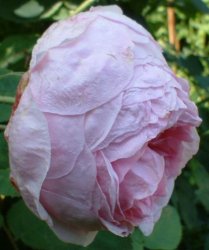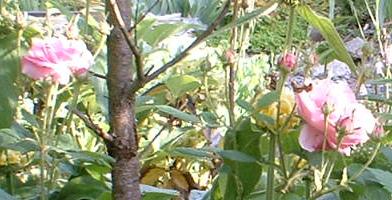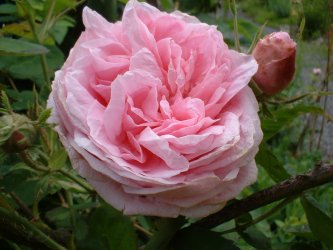
"the name of the rose"
Reflections on the name of the rose(s) after an experience with a bouquet of rosesThe railroad garden contest
Some years ago, 1995 ,I was very lucky to find three Centifolia roses , on different locations along the oldest railroad ( 1840 ) of the European Continent.
According to old maps , they still survived from the disappeared gardens of the houses of railroad officials
Many of those houses have been demolished , but the Company kept the property of the garden and their maintenance came in hands of those people who are roughly mowing once a year the slopes of the railroad to avoid the trees and shrubs to become too big .
Interesting is to know that the surviving roses are there for more than 50 if not 150 years and not without a reason . For many years , at last until 1950 , there was a garden contest , a competition between railroad gardeners ! Now in 2005 , with the construction of the HST, everything has disappeared .
Another interesting observation is that the Roses did not form shrubs , the repetitive mowing seems not to be the only reason . In fact the Roses occupied a large area , having bunches of flowering stalks spread between the grasses and shrubs . It is told that Centifolias are not suited for borders and what I saw was apparently the natural habit of these roses .
 At first sight there is no difference between those three shrubs ( prickles , leaves , petals , stems , color , odor )
At first sight there is no difference between those three shrubs ( prickles , leaves , petals , stems , color , odor )Only a trained eye might find them different .
Nevertheless there is a difference in the way the flowers open and show their petals ( or do not ).
Let us call it a statistical difference for the flowers shrub by shrub .
For one shrub almost all the flowers open very well, one is intermediate and the third does not show all the flower-leaves , as if the outer petals enclose them , for most of the flowers.
According to some pictures and paintings the last one should be the Cabbage rose or Rose des peintres.
Nobody knows where this beauty came from ( country , parentage , age )
some people think that it is a very old garden plant and others pretend that it is a rose species.
I only can guess and give an opinion according to some observations and acceptable information .
Assumptions , believers ,troubleshooters
 Many good rose books give different names and pictures for the Centifolias .
Many good rose books give different names and pictures for the Centifolias .According to Thomas ( Hurst ) , Testu and others , the Centifolias came from Holland and are of recent date
Others assume that this rose was already in Europe even before the Romans
I'm not able to choose between those extreme assumptions and unable to give other possibilities , but let's make two critical notes . Hurst made his scientific work around 1920 , but I could not find other papers confirming his work which is not good for its scientific value . With the modern instruments it would be easy to confirm or correct his work , however his method never can prove that the Centifolia originated from Holland .
Another strange thing is that it is admitted that almost all old roses ( Gallica , Damas , Alba ) were known in the Ancient World from Europe to Persia , and cultivated for their medicinal value , used in pagan rituals and festivities and for decoration ( see Histoire des Roses , Roger Phillips and Martin Rix and also Roses Anciennes ... , Jacob Grimm et al ) . but not the Centifolia ?
On the other hand when the trade by sea connected again Europe and the Far East we got Chinese influences in the roses , direct or indirect ( Bourbon ) . Nobody mentions the Centifolia but the Rose was there almost at the same time . Is it possible to clarify something by one of the many names of the Centifolia ?
This question seems very simple but the answer is complex and is charged with history .
Understand the period when the Rose(s) came to us
 We have to go back to the 17th Century ( and even a little before ) but to describe what was going on then
we must be aware that a lot of our actual notions did not exist at that moment or had another meaning.
We have to go back to the 17th Century ( and even a little before ) but to describe what was going on then
we must be aware that a lot of our actual notions did not exist at that moment or had another meaning.The actual nations did not exist and borders changed by wars and also by marriages of the noble people .
Holland did not exist in its actual form , actual notions as Dutch-speaking area or Low-lands of Europe is an approximation The best historical approach is perhaps the "Seventien Provincien" , almost the actual BENELUX trade union
( Belgium , Nederland and Luxembourg ).
At that moment Europe was burning for several reasons : economical ; religious and so on , under these circumstances ,
according to current school manuals "poor" people came to the Lower Lands from all over Europe .
I contest the word "poor" because this people still had in their luggage a lot of skills ; science ; good taste etc. the real poor stayed at home.
This is very important because at the Lower-lands there were already scientists ; mathematicians ; botanists and ... cattle breeder ; etc.
By these events we got a concentration and reinforcement , a real boost of science and trade ;
Especially the last is important because there existed the " VEREENIGDE OOSTINDIESCHE COMPAGNIE ( V.O.C.) "
( translation : United East Indian Company) It is important to notice that the word " United " means that there were other companies before and they were not all situated in ( the actual ) Holland Note that the important position for Holland is of a later date .
As the short-cut to India (Suez canal) did not exist , the ships went by The Cape ( South Africa ) A stopping-place with a settlement of people coming from the Lower Lands including those people coming from all over Europe which still can be retraced by looking at the family names
NOW THE WORD CABBAGE
 As Thomas states ( The Graham Stuart Thomas Rose Book p 54 ) ; " The unfortunate title of Cabbage Rose has led to considerable confusion ...." ;
cabbage rose to his local friends means old rose and not especially Centifolia
As Thomas states ( The Graham Stuart Thomas Rose Book p 54 ) ; " The unfortunate title of Cabbage Rose has led to considerable confusion ...." ;
cabbage rose to his local friends means old rose and not especially Centifolia One day , this passage got a special meaning to me . It was the day , my wife and me , we had a nice walk and as always I have something with me to take cuttings and collect seeds . This day we found an abandoned garden of a clergy-man ( priest ) near to Brussels with a lot of blooming old roses . For my wife I made a bouquet of roses ; Moonlight, Oeuillet de Flandre , Alba Maxima , Georges Vibert and some others unknown to me .
The local dutch-speakers exclaimed "boerenrozen".
My wife having notions of the local dialect , always interesting if you want more detailed information , informed me that this is a general word for old roses .
Does this mean that the actual dutch gardeners call all this roses , "roses of the farmers" ( modern translation ) or do they say "rose of the boers" (referring to an older word that you can still find in the word " BOER-war " of South Africa) ?
As you know that all these roses were propagated by cuttings,
why the locals do not call them roses of the clergy , of the church , of the monastery or from the chateau , the places where the cuttings came from ?
This is not the place to give the ( social ) history of agriculture but it seams reasonable that roses only were for a select public , and this for many decades . The word "Boer" can actually have many connotations depending on the context , but here we have to do with an older form surviving in local dialects .
 Now that I have good reasons to think that Dutch-language - South Africa - 17th century and trade is an acceptable route ,
we can concentrate on the word CABBAGE.
Now that I have good reasons to think that Dutch-language - South Africa - 17th century and trade is an acceptable route ,
we can concentrate on the word CABBAGE.To dutch speakers the word "Cabbage rose" and "Kaapse roos" sounds alike , the meaning of Kaapse is "coming from the Cape " another possibility is also that this rose was growing or cultivated over there .
Other names :
Some books mention Hollandica and Batavica in the rose name,It is for sure that the V.O.C. archives contain information on the names of the ships and the settlements overseas .
On older maps you can find that names as Hollandia and Battavia were in use .
It is possible that what is now one of the names of the rose , in earlier days was just an information on the way this rose came to us .
My assumption is now that the V.O.C.-company brought by ship roses from India ( Persia ? Japan ? China ) to the Cape
where they were cultivated and bred by the newer people (see above) ... and the cattle breeder .
Some good plants or results were sent to the Low-lands were they were ( only or mostly ) cultivated for sale .
May I add to this assumption an observation:
In general when the roses were sold in France they got a new French sounding name for commercial reasons, but not always and in some cases the original Dutch name has just been deformed . In the case of the Cabbage rose(s) it is not really a deformation but another spelling , got it ?
 1. The confusing difference between my three centifolias can be explained by cuttings done in the past.
1. The confusing difference between my three centifolias can be explained by cuttings done in the past.It is known that cuttings of roses may give different results if they are coming from different places of the branches.
Growing centifolias from cuttings is very difficult but not impossible, cuttings with a part of the root gives acceptable results . Sporting and back-sporting is an other explanation
Seedlings is less probable as the plant is considered as infertile ( too double )
- my Centifolias have always some hips with sometimes one big seed ( max : 3 ) , I've got seedlings but all died in winter
except one
ten years old , never reached 10 cm and never bloomed
- My Centifolias give always some whiter and less double flowers in fall , under better climatic conditions we can get fertile seeds ?; It is stated by others that the reblooming capacity is of Chinese-rose influence .
2. If it is a (very) old rose ..we must consider also other possible ways of importation.
- by land on the Silk Road : ( China , Turkey , Genua , Europe) not impossible but the plants had to pass and survive deserts.
- by sea : (China , India , Zanzibar , Persia ) more possible and in this case this rose was already in Europe in (before) Roman times.
3. Where the rose came from is a point of big discussion ,I can only give a personal interpretation .
From Holland : Rose des peintres and Rosa provincialis referring to an old name "Seventeen Provincien"
which has nothing to do with the Provence of France nor Provins a city of France.
Some confusing names are just coming from bad latinisations in the past .
4. More bad and amusing news is coming ;
The French translation of "Cabbage rose" is "Rose Chou " ,
in a dutch book "Rose Chou" was translated to "Grote spruit ( Big sprout ) "
If we can wait now for another three hundred years , the re-re-translation may become "Chou de Bruxelles".
HOME